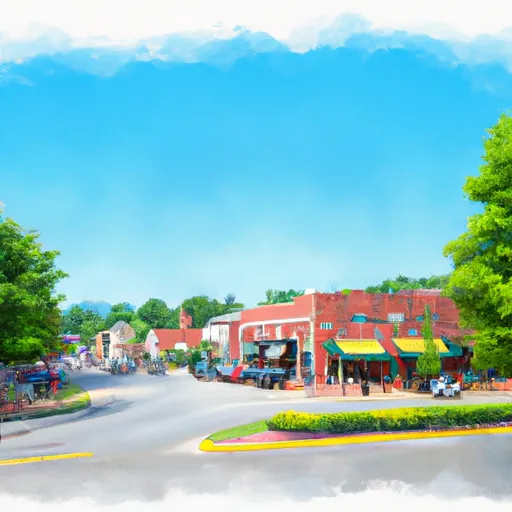-
 Snoflo Premium
Snoflo Premium
Get unlimited access to all our content
With no Ad interruptions! - Start Your Free Trial Login with existing account
Mascot
Eden Index
Climate
8.0
•
Recreation
3.4
•
Community
1.0
•
Safeguard
4.6/10

Mascot, Tennessee is a small community located in Knox County. It experiences a humid subtropical climate, characterized by hot summers and mild winters. Summers are typically hot and humid, with average temperatures ranging from the mid-80s to low 90s Fahrenheit. Winters are generally mild, with average temperatures in the mid-40s to low 50s Fahrenheit. The area receives a moderate amount of precipitation throughout the year, with the wettest months being May and November.
Mascot is surrounded by several water bodies, including the Holston River and several smaller creeks and streams. These hydrology constituents provide opportunities for fishing, boating, and various water sports. The Holston River is particularly known for its diverse fish population, including species such as bass, trout, and catfish.
Outdoor recreation enthusiasts can enjoy a variety of activities in Mascot and its surrounding areas. The community is near the Seven Islands State Birding Park, which offers hiking trails, wildlife viewing, and bird-watching opportunities. Additionally, the nearby Great Smoky Mountains National Park provides endless outdoor activities, including hiking, camping, wildlife viewing, and scenic drives.
What is the Eden Index?
The Snoflo Eden Index serves as a comprehensive rating system for regions, evaluating their desirability through a holistic assessment of climate health, outdoor recreation opportunities, and natural disaster risk, acknowledging the profound impact of these factors on livability and well-being.
Climate Health Indicator (CHI): 8.0
Mascot receives approximately
1247mm of rain per year,
with humidity levels near 84%
and air temperatures averaging around
14°C.
Mascot has a plant hardyness factor of
7, meaning
plants and agriculture in this region tend to thrive during the non-winter months.
By considering the ideal temperature range, reliable water supplies, clean air, and stable seasonal rain or snowpacks, the Climate Health Indicator (CHI) underscores the significance of a healthy climate as the foundation for quality living.
A healthy climate is paramount for ensuring a high quality of life and livability in a region, fostering both physical well-being and environmental harmony. This can be characterized by ideal temperatures, reliable access to water supplies, clean air, and consistent seasonal rain or snowpacks.
Weather Forecast
Streamflow Conditions
French Broad-Holston
Area Rivers
French Broad-Holston
Snowpack Depths
French Broad-Holston
Reservoir Storage Capacity
French Broad-Holston
Groundwater Levels
Recreational Opportunity Index (ROI): 3.4
The Recreational Opportunity Index (ROI) recognizes the value of outdoor recreational options, such as parks, hiking trails, camping sites, and fishing spots, while acknowledging that climate plays a pivotal role in ensuring the comfort and consistency of these experiences.
Access to outdoor recreational opportunities, encompassing activities such as parks, hiking, camping, and fishing, is crucial for overall well-being, and the climate plays a pivotal role in enabling and enhancing these experiences, ensuring that individuals can engage in nature-based activities comfortably and consistently.
Camping Areas
| Campground | Campsites | Reservations | Toilets | Showers | Elevation |
|---|---|---|---|---|---|
| Old Federal - Lake Lanier | None | 1,108 ft | |||
| River Forks - Lake Lanier | 73 | 1,123 ft | |||
| Boggs Creek | 31 | 1,798 ft | |||
| Unicoi State Park | None | 1,678 ft | |||
| Vogel State Park | None | 2,323 ft | |||
| Laurel Park - Lake Lanier | None | 1,118 ft | |||
| Desoto Falls | 44 | 2,195 ft | |||
| Bolding Mill - Lake Lanier | None | 1,102 ft | |||
| Duckett Mill - Lake Lanier | None | 1,163 ft | |||
| Low Gap Creek | 13 | 1,792 ft |
Nearby Ski Areas
Catastrophe Safeguard Index (CSI):
The Catastrophe Safeguard Index (CSI) recognizes that natural disaster risk, encompassing floods, fires, hurricanes, and tornadoes, can drastically affect safety and the overall appeal of an area.
The level of natural disaster risk in a region significantly affects safety and the overall livability, with climate change amplifying these risks by potentially increasing the frequency and intensity of events like floods, fires, hurricanes, and tornadoes, thereby posing substantial challenges to community resilience and well-being.
Community Resilience Indicator (CRI): 1.0
The Community Resilience Indicator (CRI) recognizes that education, healthcare, and socioeconomics are crucial to the well-being of a region. The CRI acknowledges the profound impact of these elements on residents' overall quality of life. By evaluating educational resources, healthcare accessibility, and economic inclusivity, the index captures the essential aspects that contribute to a thriving community, fostering resident satisfaction, equity, and social cohesion.

